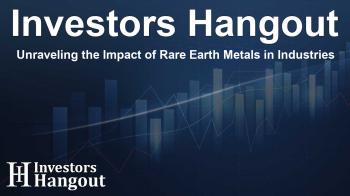Unraveling the Impact of Rare Earth Metals in Industries

Understanding the Rare Earth Metals Market
The global market for rare earth metals is witnessing a significant transformation, projected to reach an impressive USD 7,386.3 million by 2030. This projection stems from growing demand across various high-tech sectors, including clean energy, electronics, and defense technologies. In 2024, the market was valued at USD 5,139.1 million, indicating a strong growth trajectory fueled by the need for sustainable solutions and advanced technologies.
What Are Rare Earth Metals?
Rare earth metals encompass a group of 17 elements that are abundant in the Earth's crust but are often difficult to extract economically. These metals, including lanthanum, cerium, and neodymium, boast unique properties like strong magnetism and electrical conductivity, making them invaluable in various applications. As critical minerals, they play a crucial role in the production of clean energy systems and modern electronics.
The Rise of Neodymium Oxide
Key Market Drivers
The neodymium oxide segment is emerging as a leader in the rare earth metals market, primarily due to its essential role in manufacturing high-performance permanent magnets. These magnets are vital for electric vehicles (EVs), wind turbine generators, and a host of consumer electronics. The surge in demand for sustainable mobility and renewable energy technologies has galvanized the neodymium market, making it a focal point for producers and investors alike.
Applications and Growth Trends
As the world continues its transition towards electric mobility and renewable energy, the demand for neodymium oxide is expected to skyrocket. Industries are increasingly looking for efficient and durable electric motors, which rely heavily on neodymium-based permanent magnets. Furthermore, as defense sectors and medical device manufacturers seek advanced materials, the consumption of neodymium oxide is anticipated to grow significantly, reinforcing its position in the rare earth market.
Permanent Magnets: A Key Application
Permanent magnets represent the largest segment of the rare earth metals market, driven by unprecedented demand from electric vehicles and renewable energy sectors. The efficiency of electric motors depends significantly on these rare earth elements, positioning them as essential materials for growth. Industries, from automotive to consumer electronics, are increasingly reliant on high-strength magnets to power devices ranging from EVs to smart devices.
The Asia Pacific Market Landscape
Market Leadership
In 2024, Asia Pacific emerged as the dominant player in the rare earth metals landscape, largely driven by China's unrivaled production capabilities. With a robust manufacturing sector and rapid consumption of clean energy technologies, this region is consistently pushing the boundaries of innovation. Significant contributions from countries like Japan and South Korea, which have advanced technological sectors, further bolster the demand for rare earth metals.
Emerging Economies and Industrialization
Regions such as India and Southeast Asia are witnessing a surge in industrial development, thereby increasing the consumption of rare earth metals. Governments are enhancing policies to direct investments into local processing and recycling technologies, which is helping to consolidate the market further in Asia Pacific. As the global community focuses on securing sustainable supply chains, the significance of this region in the rare earth metals market cannot be overstated.
Key Players in the Market
Prominent players in the rare earth metals market include Lynas Rare Earths Ltd., Australian Strategic Materials Ltd., Arafura Rare Earths Limited, and MP Materials. These companies are actively involved in strategic expansions, acquisitions, and product developments to enhance their market presence. Their commitment to innovation and sustainability positions them well in this rapidly evolving market.
Frequently Asked Questions
What are rare earth metals?
Rare earth metals refer to a group of 17 elements known for their unique properties, crucial in modern technology and clean energy applications.
What is driving the growth of the rare earth metals market?
The shift towards electric mobility, renewable energy, and advanced electronics is significantly boosting the demand for rare earth metals.
Which regions dominate the rare earth metals market?
Asia Pacific, particularly China, leads the market due to its production capabilities and the rising demand for clean energy technologies.
Why is neodymium oxide important?
Neodymium oxide is vital for creating high-performance magnets used in electric vehicles, wind turbines, and various electronics, driving its demand.
Who are the major players in the rare earth metals market?
Key players include Lynas Rare Earths Ltd., Australian Strategic Materials Ltd., Arafura Rare Earths Limited, and MP Materials, focusing on market expansion and innovation.
About The Author
Contact Olivia Taylor privately here. Or send an email with ATTN: Olivia Taylor as the subject to contact@investorshangout.com.
About Investors Hangout
Investors Hangout is a leading online stock forum for financial discussion and learning, offering a wide range of free tools and resources. It draws in traders of all levels, who exchange market knowledge, investigate trading tactics, and keep an eye on industry developments in real time. Featuring financial articles, stock message boards, quotes, charts, company profiles, and live news updates. Through cooperative learning and a wealth of informational resources, it helps users from novices creating their first portfolios to experts honing their techniques. Join Investors Hangout today: https://investorshangout.com/
The content of this article is based on factual, publicly available information and does not represent legal, financial, or investment advice. Investors Hangout does not offer financial advice, and the author is not a licensed financial advisor. Consult a qualified advisor before making any financial or investment decisions based on this article. This article should not be considered advice to purchase, sell, or hold any securities or other investments. If any of the material provided here is inaccurate, please contact us for corrections.

